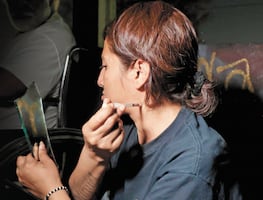Más Información

Sellan información sobre bienes de Hernán Bermúdez; divulgarla entorpecería investigación, señalan autoridades

Economía mexicana inicia con el pie izquierdo el segundo trimestre, reporta debilidad en tres grandes sectores
It is almost nine o'clock at night and fans are anxious in Mexico's Neza Arena, an old and dingy building in one of the most crime-ridden suburbs of Mexico City.
Impatient, they scream and whistle louder and louder to urge the fighters to begin the show, including fights that spill out beyond the ring.
"We're extreme fighters, but we're not violent. We already have too much violence in this country," said Crazy Boy, head of a company that used to be called Total Ultra-Violent Disaster, or DTU in Spanish, the old name a reference to Mexico's brutal drug violence.
The nine-year-old company has zeroed in on fans who want to see wrestling that is different - and bloodier - than Mexico's traditional, deeply rooted version in which the fights are often more spectacle that real combat.
"People come here to enjoy themselves, enjoy what they see, and they're always asking for something more," added Crazy Boy, who declined to give his real name because he said keeping separate identities is key to preserving the sport's allure.
Crazy Boy's company was re-branded about a year ago in an effort to distance it from violent connotations and is now known as DTU Mexican Professional Fighting.
While extreme fights have become increasingly popular in the country, DTU has a lower profile than the more famous professional "Lucha Libre" circuit and tends to book smaller venues.
When the time comes for the Extreme Star Fight, six wrestlers climb into the ring. Once the fighting begins, anything goes. They bash each other with chairs and long neon lights, causing small explosions and scattering tiny pieces of glass everywhere.
The fighters, about half of whom wear masks, even use plastic knives and forks to hurt their opponents.
Quickly, blood begins to stain the faces of the combatants and the crowd goes wild, shouting even louder. The screaming and yelling goes on for some time as fans swear at the fighters who ignore them.
After 15 minutes of pitched battle in and out of the ring, a pair of winners emerges as a referee raises their arms in victory.
Their faces, tired and bloodied, still manage a smile of satisfaction. But it only lasts a brief moment as new challenges and insults come at them almost immediately.
There's a heavy tension in the air for a few minutes as losers hurl insults at the winners, vowing to take revenge, which is all part of the show. But in the end everyone hugs and praises each other's physical skills.
Ironically, a fraternal show of brotherhood marks the end of the night.
Many fans head for the exits while others seek out autographs and selfies with their favorite fighters.
Meanwhile, the arena's cleaning staff begins to clear the trash and clean up the spilled blood that covers the ring, proof that this indeed is extreme fighting.











